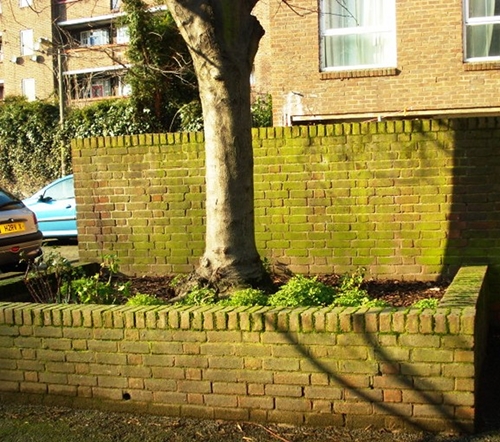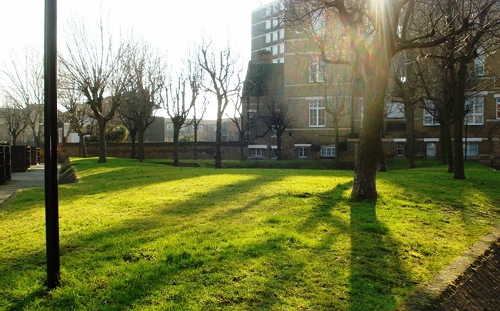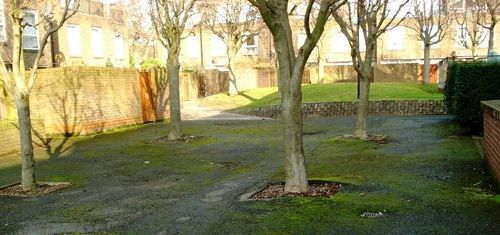George Arkless is the Chair of the Haddonhall TMO, Southwark, London. Here he writes exclusively for SOW about the consequences of poor planning for tree planting, a timely reminder that we should be following the advice of the Tree Council and others advocating ‘The Right Tree in the Right Place’.

Photo credit: Arkless
‘While I love trees and hate to see them being removed unnecessarily I am in the unenviable position of campaigning for the right to reduce the number of trees on our estate.
The estate was built between 1979 and 1981 and for some reason the developers decided to plant trees in as many places as they could regardless of their suitability in the long run. Now 30 years later we are seeing the consequences of any lack of thought, other than trees are good so we must plant as many as possible.
This included bricked flower beds and grassed areas, despite the fact that the grass was to hide a huge amount of rubble. In 2005 when I joined our tenant management organisation we had 169 homes and 169 trees, mainly London Planes. I am told this was after the tenants co-operative had removed a large number of trees in the early days.
Poor planning, in the residents view, means that the problems we now face are numerous, and while anyone from the council we have invited to look at the problems have agreed with us felling trees is such a sensitive matter that no one has been willing to put it in writing.
The types of problems are numerous, from a play area we have had to fence off because the roots of a tree has made a wall unstable and has shifted parts of the wall up to 1cm from its foundation, to trees where the root of the trees have been pushed above ground and an adult can ‘rock’ them. Nor is it healthy for the trees. Opposite where I live for the last three summers, at least, there are two trees next to each other and in full bloom where the branches meet hardly any leaves grow at all.
Poor management has compounded the problem and means that much of the natural beauty of the trees are long lost. From my point of view, getting permission to cut trees down would allow us to move to the next stage, which would be to review all our trees with an Arborist so that we can bring trees into our strategy to improve the biodiversity of the estate. Also so that we can get a better idea of how best to manage them for their own health. It would hugely help us also in planning for the replacement of some of the trees so that we do not repeat the mistakes of the past.
We have already undertaken projects to improve the diversity of plants on the estate, and are looking to providing hedges and berry plants to improve the bio diversity, and an ambitious plan to have a community orchard, providing free fruit for the residents. As part of this strategy I am also looking at the possibility of introducing wormeries so that food can be recycled, with the added bonus of providing free fertiliser.
I have already seen some surprises from the changes we have already made. For instance we do not mow the grass as often as we used to and this year I have counted seven different varieties of mushrooms growing on the estate. As I’m not a gardener, or a professional I often find the plants that delight me the most are ones that are commonly considered weeds, but have a role to play. Having a gardener has helped me to appreciate more the many wonders of our new plantings.
For me trees should be an important part of this mixture, moving away from a sterile concrete / metal jungle to one where people and nature can co-exist side by side with each other. I get a lot of pleasure from doing simple things, like watching a daisy wake up in the morning or go to sleep at night, watching bugs, insects and birds and while I do not like spiders there is something magical watching the morning dew play on their webs.
Just as there is delight when I get out of London and see trees in their true magnificence, or seeing a tree that is alive with life, or a tree so beautiful it just takes your breath away. Why should I need to leave the neighbourhood I live in to see such beauty around me?’





























Having sifted through all the Sunday newspapers it was this article that finally satisfied my Sunday thirst for a good, factual and heart warming article to read with a good cup of coffee. Really excellent George and Save Our Woods, thank you.
This beautifully illustrates the need for planning not just for people but with people.
A great article highlighting that even us Londoners can have too much of a good thing. A tree is for life and not just for decor and every one needs some kind of management at some time. You’re lucky to have an arborist – most are contractors who only know one end of the chainsaw from the other.
Thank you Laura,
As a tenant managed organisation it is important to realise that we don’t have the expertise in many areas and getting the right people to advise us is essential in managing our grounds.
As I said in the article the trees have been poorly maintained in the past, the worst case I saw was when co-op paid to have the trees tended and the person doing it simply lopped off the top. I guess if all you want is the cheapest solution you get what you pay for.
Getting in the right advice should help us to save some of the trees and ensure they are better treated in the future, it will also allow us to discuss some replacements not only in terms of suitability for location and future commitment to care but also to add to the value in terms of wildlife. Are all trees good for wildlife? I have no idea.
Another issue that I did not discuss is that of choosing foriegn trees or using native trees? Japanese Maple in my mind is a fantastic looking tree, but would the field maple provide a similar display or are there other issues we may not be aware of.
Are there other native trees that would fit in well and do well where we are that we should consider? Questions that we would benefit well from getting the proper advice, and worth seeking out in my opinion.
{ 2 trackbacks }